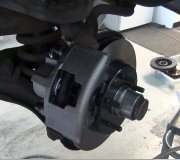We used to rebuild calipers as part of regular brake jobs as late as the 1980's, but they cause so little trouble today that few people still know how to do that job. There is three things you need to consider. The first is debris often settles at the lower part of the bore. That must be cleaned out or it will interfere with the piston retracting far enough to allow the new pads to be installed. You must be able to force the piston in with strong hand pressure and a wiggling motion. If you have to rely on the dreaded C-clamp, replace the caliper instead. The piston is catching on that debris or it is catching on and is going to flip the rubber square-cut seal. Flipping that seal will result in a leak and preventing the piston from sliding freely. That debris at the bottom of the bore is a common cause of sticking brakes after new pads are installed. Few do-it-yourselfers are aware of this potential problem. That is why there is so much more involved in a professional brake job than just slapping on new pads.
Second, you must inspect the piston for signs of rust spots or lifting of the chrome plating. If you see that, it must be replaced. Do not waste your time trying to scrape rust off. Once the chrome has lifted, the piston will continue to rust, and those spots will cause it to stick on the square-cut seal. That will prevent that brake from applying under light brake pedal pressure, and it will not release smoothly. Usually you will find a ring of impacted debris around the piston. That will also prevent the piston from sliding freely, but unlike with rust spots, that debris can be washed and scrubbed off with Brake Parts Cleaner.
Third, if you do these inspection steps, it means you pulled the piston out of the dust boot. Getting it back in can be very frustrating and time-consuming. From doing this so often, I became proficient at blowing them up with compressed air through the port where the hose attaches. Just about no one has success doing that unless you have seen it done first by someone else. It still takes a lot of practice to get good at it. Another method is to place the boot on the piston first, then use the piston as a handle as you poke the other end of the boot into the groove in the caliper housing. That works okay when you are installing a new boot from a rebuild kit, but you have to be sure the groove is cleaned out really well. On older calipers, that boot will be glued in by rust and debris, so it is best to just leave that end alone when it is not being replaced. The third method for getting the boot to expand around the piston is to use a special pliers made just for this purpose. They are available in two or three different sizes for different size boots. I have also heard of people using a bunch of thin pieces of wood around the boot to pull it open as they slide in the piston. I suppose you could also get a pile of friends to use hooked tools to pull the boot open as you drop the piston in.
There is one more thing to be aware of. Many rear calipers incorporate the parking brake mechanism. Those will have a threaded shaft coming out the rear of the housing that the lever attaches to. Those are special, very expensive pistons that have to be rotated with a special tool to retract them. Those have to be filled with brake fluid and bled before they are installed. If that is not done, the air will never bleed out of them later. This can also be very frustrating, often with limited success.
Throughout all this, it is critical that absolutely no hint of petroleum product gets on anything that is going to be in contact with brake fluid. The slightest film of engine oil, transmission fluid, axle grease, power steering fluid, or penetrating oil will contaminate the entire system. The only proper repair for that is to remove every part that contains a rubber part, including seals and hoses, flush and dry the steel lines, then replace all those rubber parts. That is a very expensive repair, and it is even worse if the vehicle has an anti-lock brake hydraulic controller, as those contain rubber o-rings. Professionals even wash their hands with soap and water before assembling calipers, to avoid getting fingerprint grease on the parts.
There is a real lot more involved in a standard brake job, mostly having to do with use of a special high-temperature brake grease, and attention to mounting hardware. Here is a link to an article that can provide much of that information:
https://www.2carpros.com/articles/brake-caliper-replacement
Tuesday, October 9th, 2018 AT 2:00 PM



